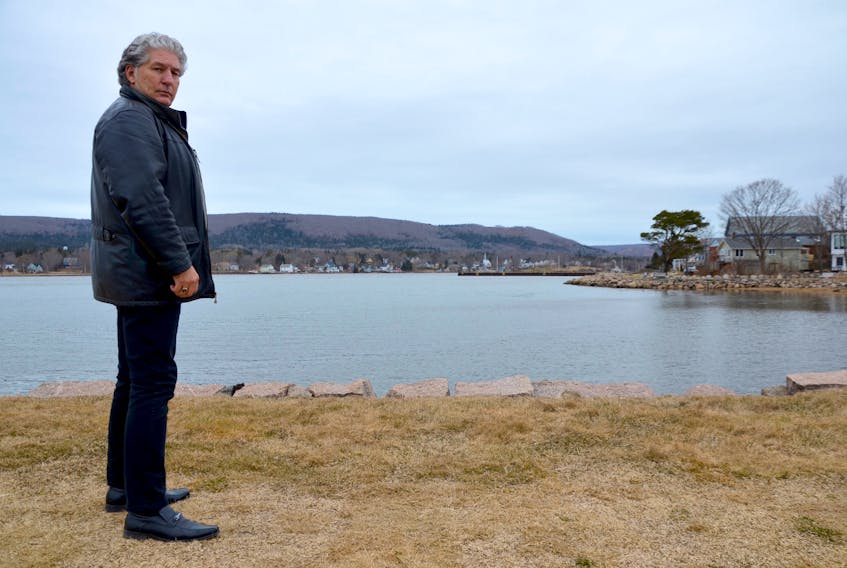ANNAPOLIS ROYAL, NS - When it comes to rising sea levels, Annapolis Royal has a lot to lose. But the mayor and council aren’t sitting idly by waiting to be rescued.
They’re about to establish a committee to tackle environmental issues with rising water levels expected to be chief among those concerns.
“I don’t want to scare people, but we cannot be blind to what’s happening,” said Mayor Bill MacDonald from his office scant metres from the edge of the Annapolis Basin. “We have to do something, and this mayor and council are committed to it. Citizens in this area and town are committed to it.”
He said locals often walk along the waterfront during storms to see the storm surge just because it’s exciting, dramatic, and dynamic. “But without a doubt we now walk along that water front on a storm surge and we see how high the water is actually getting. It foreshadows, I think, what we can expect from the future.”
Due to flooding and storm surge, water now tops the wharf at the bottom of St. George Street by three inches every 18 to 24 months, according to a study done by the Clean Annapolis River Project. Ecologist Hague Vaughan told a recent meeting of concerned area residents that by the year 2030 the wharf will be topped by as much as 18.7 inches about 12 to 13 times a year. Vaughan’s figures come from the US National Oceanic and Atmospheric Administration’s Global and Regional Sea Level Rise Scenarios for the United States released about a year ago.
Research scientist’s maps show how sea level rise will affect Nova Scotia communities
Stakes Are High
For Annapolis Royal, and many communities on both sides of the Annapolis Basin, the stakes are high.
“We characterize our town as the Cradle of Our Nation,” said MacDonald. “Part of that is reflected in the inventory of built heritage that we have in this town. We have an enormous collection of designated heritage buildings, many of which are along St. George Street along the waterfront. If we don’t have a solution, if we don’t solve the pending problem, we will lose irreplaceable relics of important times in the history of Canada.”
Those figures quoted by Vaughan at the Feb. 13 meeting of residents at the United Church are considered conservative. Documented sea level rise has been about 33 centimetres a century. For instance, the tide gauge record of Charlottetown from 1911 to 1998 shows a relative sea level rise of 32 centimetres. That’s about a foot. But projections are a rise possibly as high as two metres by the end of the century.
“Certainly I accept the expert evidence of Hague Vaughan that day who has a lot of insight into the nature of rising tides and the environment,” the mayor said. “While we can dispute the timelines of these kinds of things, we all know -- because we see it and experience it -- there is a problem with rising sea levels.”

Mitigation
“We can’t leave it for anybody else. So what we do, and how we do that, and how we mitigate, that is really the issue,” the mayor said. “The town is actually taking the initiative to reach out to our surrounding partners – the County of Digby, the Town of Digby, the Municipality of the County of Annapolis – to come together in a joint initiative to look at some kind of mitigation of rising sea levels looking at the Digby Gut as a source of where we might consider some possibilities. We don’t know what those are.”
He explained that Infrastructure Canada has an initiative seeking input and applications from communities on proposals that might be worth considering.
“They’re encouraging applicants to be as grand as possible in their thinking, and so we certainly are,” he said. “Again, back to the facts that these are the highest tides in the world, whatever we’re going to do is going to be significant. It’s going to be dramatic, and it may be an engineering colossal on one level because of the tides and the impacts of the tides and the strengths of the tides. You can’t stop the tides of the Fundy. What you might be able to do is displace, mitigate in some way. I’ll leave that to engineers to figure that out, but certainly we don’t want to sit on our hands here. We want to be part of the solution.”
The town’s CAO was to make a presentation to Annapolis County council on March 13.
“If the application is successful, there is significant funding to have the engineers, the people who know about these things, have a look at the Gut to see if there is some way that we can actually mitigate this.”
Moving Towards Action
Annapolis Royal’s town council has been moving towards action for more than a year, and the mayor credits in particular an Earth Day march designed to draw attention to such things as climate change and sea level rise.
MacDonald said it was feedback the town got from that that helped get things rolling.
“Holly Sanford, a councilor, had gathered a bunch of names of people who were interested in sitting on any kind of a committee that might happen. It’s taken a while but we’ve been moving in this direction,” he said.
More recently he was approached by the United Church’s group that deals with environmental issues, asking what the town was doing.
“I was happy to say that timing is everything because council had just had a meeting where we talked about establishing a climate committee of some kind, an environment committee,” MacDonald said. “We really didn’t know what to call it. I kind of favoured a community sustainability committee, but ultimately at the end of the day it’s being seen as environmental advisory committee.”
On March 1 the town’s Committee of the Whole passed a motion to recommend to council the approval of a policy establishing the environmental advisory committee. MacDonald expects council will approve the recommendation on March 19 at its regular meeting and the committee will be formed.
Committee
The committee will have one councillor on it and the rest will be four or five members of the public with the mayor as ex officio.
The committee would provide pro-active measures, educate, promote, provide feedback and recommendations on environmental issues related to sustainability, advocacy, and stewardship within the Town of Annapolis Royal. It would also review and update the town’s existing climate change document annually.
“You can see, certainly, that the whole plan is to start doing some heavy lifting, not wait for the next administration, or the next administration,” said MacDonald. “We all recognize that tides are rising. Those of us living in town see the surges -- that they’ve increased, that they’re significant. We as a community that’s been here for 400-plus years have experienced the ravages of fire. Modern fire protection has ensured that won’t happen the way it happened in the past, but our new threat, and our most significant threat now and in the future, is water. There is nothing that an old wooden building hates more than water.”









